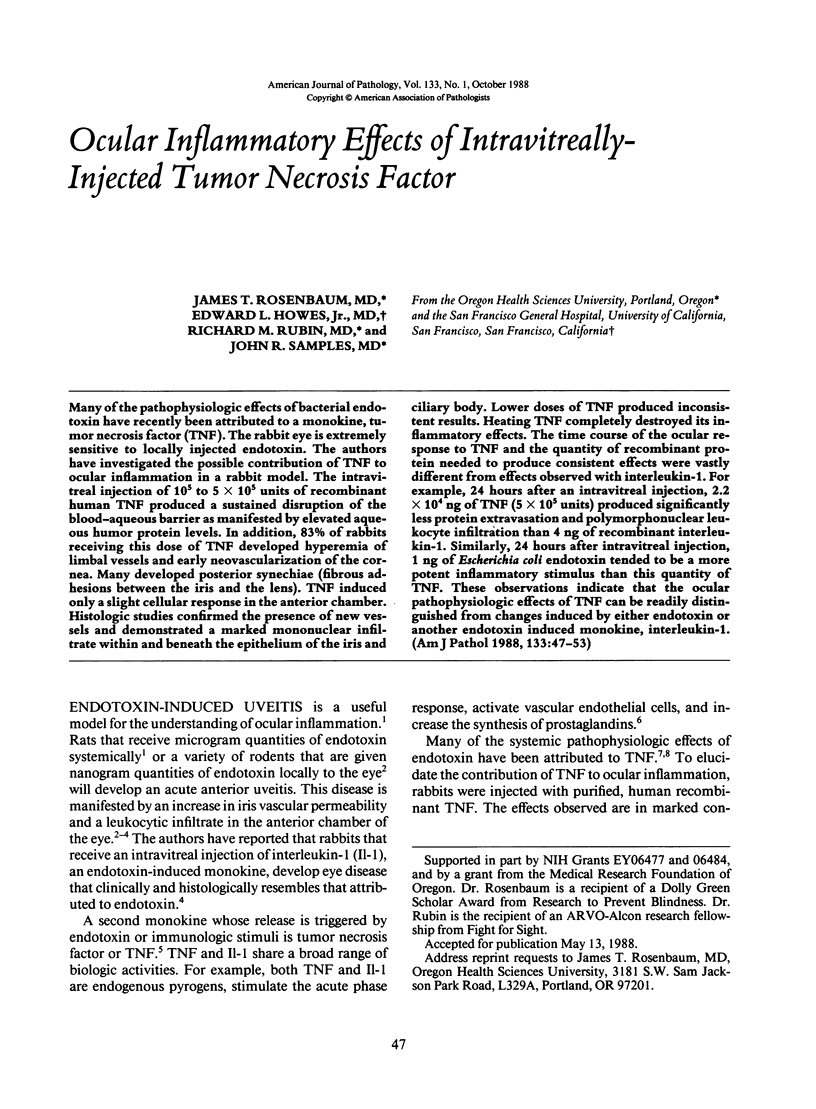Abstract
Many of the pathophysiologic effects of bacterial endotoxin have recently been attributed to a monokine, tumor necrosis factor (TNF). The rabbit eye is extremely sensitive to locally injected endotoxin. The authors have investigated the possible contribution of TNF to ocular inflammation in a rabbit model. The intravitreal injection of 10(5) to 5 X 10(5) units of recombinant human TNF produced a sustained disruption of the blood-aqueous barrier as manifested by elevated aqueous humor protein levels. In addition, 83% of rabbits receiving this dose of TNF developed hyperemia of limbal vessels and early neovascularization of the cornea. Many developed posterior synechiae (fibrous adhesions between the iris and the lens). TNF induced only a slight cellular response in the anterior chamber. Histologic studies confirmed the presence of new vessels and demonstrated a marked mononuclear infiltrate within and beneath the epithelium of the iris and ciliary body. Lower doses of TNF produced inconsistent results. Heating TNF completely destroyed its inflammatory effects. The time course of the ocular response to TNF and the quantity of recombinant protein needed to produce consistent effects were vastly different from effects observed with interleukin-1. For example, 24 hours after an intravitreal injection, 2.2 X 10(4) ng of TNF (5 X 10(5) units) produced significantly less protein extravasation and polymorphonuclear leukocyte infiltration than 4 ng of recombinant interleukin-1. Similarly, 24 hours after intravitreal injection, 1 ng of Escherichia coli endotoxin tended to be a more potent inflammatory stimulus than this quantity of TNF. These observations indicate that the ocular pathophysiologic effects of TNF can be readily distinguished from changes induced by either endotoxin or another endotoxin induced monokine, interleukin-1.
Full text
PDF






Images in this article
Selected References
These references are in PubMed. This may not be the complete list of references from this article.
- Abe S., Gatanaga T., Yamazaki M., Soma G., Mizuno D. Purification of rabbit tumor necrosis factor. FEBS Lett. 1985 Jan 28;180(2):203–206. doi: 10.1016/0014-5793(85)81071-1. [DOI] [PubMed] [Google Scholar]
- Beutler B., Milsark I. W., Cerami A. C. Passive immunization against cachectin/tumor necrosis factor protects mice from lethal effect of endotoxin. Science. 1985 Aug 30;229(4716):869–871. doi: 10.1126/science.3895437. [DOI] [PubMed] [Google Scholar]
- Bradford M. M. A rapid and sensitive method for the quantitation of microgram quantities of protein utilizing the principle of protein-dye binding. Anal Biochem. 1976 May 7;72:248–254. doi: 10.1016/0003-2697(76)90527-3. [DOI] [PubMed] [Google Scholar]
- Gospodarowicz D., Bialecki H., Thakral T. K. The angiogenic activity of the fibroblast and epidermal growth factor. Exp Eye Res. 1979 May;28(5):501–514. doi: 10.1016/0014-4835(79)90038-1. [DOI] [PubMed] [Google Scholar]
- Howes E. L., Jr, Wong K. L., Hartiala K. T., Webster R. O., Rosenbaum J. T. Complement and polymorphonuclear leukocytes do not determine the vascular permeability induced by intraocular LPS. Am J Pathol. 1985 Jan;118(1):35–42. [PMC free article] [PubMed] [Google Scholar]
- Ito H., Yamamoto S., Kuroda S., Sakamoto H., Kajihara J., Kiyota T., Hayashi H., Kato M., Seko M. Molecular cloning and expression in Escherichia coli of the cDNA coding for rabbit tumor necrosis factor. DNA. 1986 Apr;5(2):149–156. doi: 10.1089/dna.1986.5.149. [DOI] [PubMed] [Google Scholar]
- Le J., Vilcek J. Tumor necrosis factor and interleukin 1: cytokines with multiple overlapping biological activities. Lab Invest. 1987 Mar;56(3):234–248. [PubMed] [Google Scholar]
- Leibovich S. J., Polverini P. J., Shepard H. M., Wiseman D. M., Shively V., Nuseir N. Macrophage-induced angiogenesis is mediated by tumour necrosis factor-alpha. Nature. 1987 Oct 15;329(6140):630–632. doi: 10.1038/329630a0. [DOI] [PubMed] [Google Scholar]
- Libby P., Ordovas J. M., Auger K. R., Robbins A. H., Birinyi L. K., Dinarello C. A. Endotoxin and tumor necrosis factor induce interleukin-1 gene expression in adult human vascular endothelial cells. Am J Pathol. 1986 Aug;124(2):179–185. [PMC free article] [PubMed] [Google Scholar]
- Nawroth P. P., Bank I., Handley D., Cassimeris J., Chess L., Stern D. Tumor necrosis factor/cachectin interacts with endothelial cell receptors to induce release of interleukin 1. J Exp Med. 1986 Jun 1;163(6):1363–1375. doi: 10.1084/jem.163.6.1363. [DOI] [PMC free article] [PubMed] [Google Scholar]
- Old L. J. Tumor necrosis factor (TNF). Science. 1985 Nov 8;230(4726):630–632. doi: 10.1126/science.2413547. [DOI] [PubMed] [Google Scholar]
- Rosenbaum J. T., McDevitt H. O., Guss R. B., Egbert P. R. Endotoxin-induced uveitis in rats as a model for human disease. Nature. 1980 Aug 7;286(5773):611–613. doi: 10.1038/286611a0. [DOI] [PubMed] [Google Scholar]
- Rosenbaum J. T., Raymond W. Monocyte chemotactic activity induced by intravitreal endotoxin. Invest Ophthalmol Vis Sci. 1985 Sep;26(9):1267–1273. [PubMed] [Google Scholar]
- Rosenbaum J. T., Samples J. R., Hefeneider S. H., Howes E. L., Jr Ocular inflammatory effects of intravitreal interleukin 1. Arch Ophthalmol. 1987 Aug;105(8):1117–1120. doi: 10.1001/archopht.1987.01060080119040. [DOI] [PubMed] [Google Scholar]
- SILVERSTEIN A. M., ZIMMERMAN L. E. Immunogenic endophthalmitis produced in the guinea pig by different pathogenetic mechanisms. Am J Ophthalmol. 1959 Nov;48(5):435–447. doi: 10.1016/0002-9394(59)90596-3. [DOI] [PubMed] [Google Scholar]
- Tracey K. J., Beutler B., Lowry S. F., Merryweather J., Wolpe S., Milsark I. W., Hariri R. J., Fahey T. J., 3rd, Zentella A., Albert J. D. Shock and tissue injury induced by recombinant human cachectin. Science. 1986 Oct 24;234(4775):470–474. doi: 10.1126/science.3764421. [DOI] [PubMed] [Google Scholar]
- Wang A. M., Creasey A. A., Ladner M. B., Lin L. S., Strickler J., Van Arsdell J. N., Yamamoto R., Mark D. F. Molecular cloning of the complementary DNA for human tumor necrosis factor. Science. 1985 Apr 12;228(4696):149–154. doi: 10.1126/science.3856324. [DOI] [PubMed] [Google Scholar]






